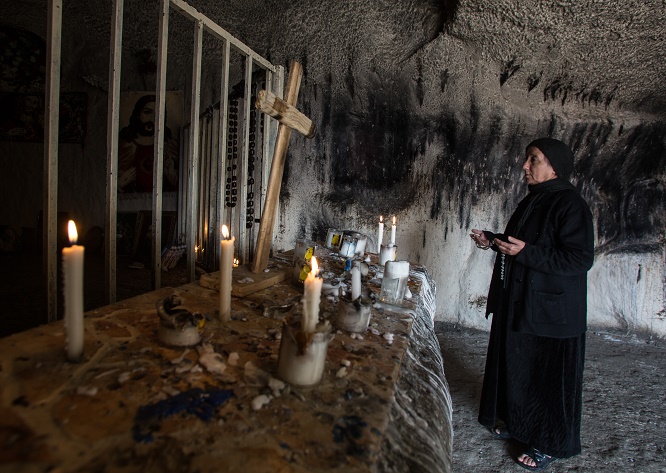Continuano ad arrivare notizie di morte e distruzione dalla Siria. Dopo la decapitazione di Khaled Asaad, ex direttore del sito archeologico di Palmira, avvenuta lo scorso 19 agosto, la furia dell’Isis si abbatte nuovamente sugli edifici religiosi.
Stavolta è toccato al monastero cattolico di Mar Elian a Qaryqatayn, vicino a Homs in Siria, costruito nel quinto secolo dopo Cristo. Gli jihadisti dello Stato islamico hanno loro stessi diffuso un video con i bulldozer al lavoro tra le rovine.
Nel video – in realtà una serie di fotografie in successione – si vede innanzi tutto la profanazione della chiesa, seguita dalla riesumazione dei resti di Sant’Elian – ucciso dai romani nel 285 – a cui il monastero era dedicato; quindi la distruzione dello storico complesso, situato nel deserto siriano. Il monastero, considerato uno dei centri cattolici più importanti della Siria, era stato ricostruito a diverse riprese nel corso dei secoli e accoglieva ogni anno il 9 settembre in occasione della festa del santo, migliaia di pellegrini. Il responsabile del monastero, padre Jacques Mouraud, è stato rapito nel maggio scorso, probabilmente dall’Isis stessa.

 ERBIL, IRAQ - DECEMBER 12: A Iraqi Christian prays inside a shrine in the grounds of Mazar Mar Eillia (Mar Elia) Catholic Church, that has now become home to hundreds of Iraqi Christians who were forced to flee their homes as the Islamic State advanced earlier this year, on December 12, 2014 in Erbil, Iraq. Although the autonomous Kurdistan region of Northern Iraq was already a refuge for an estimated 250,000 Syrian refugees, since the Islamic State began its onslaught on Iraq in June, Kurdistan has also taken in a more than one and a half million displaced people. Many have been placed in purpose-built refugee camps but the huge numbers mean thousands of others are forced to live in un-finished buildings or inadequate, makeshift shelters and as winter in the region closes in, there are growing concerns for the welfare of the refugees who, while their homes are still in ISIL controlled territory, have no realistic prospect of returning to them. Although the autonomous Kurdistan region in northern Iraq was already a refuge for an estimated 250,000 Syrian refugees, since the Islamic State began its onslaught on Iraq in June, Kurdistan has also taken in a more than one and a half million displaced people. Many have been placed in purpose-built refugee camps but the huge numbers mean thousands of others are forced to live in un-finished buildings or inadequate, makeshift shelters and as winter in the region closes in, there are growing concerns for the welfare of the refugees who, while their homes are still in ISIL controlled territory, have no realistic prospect of returning to them. (Photo by Matt Cardy/Getty Images)
ERBIL, IRAQ - DECEMBER 12: A Iraqi Christian prays inside a shrine in the grounds of Mazar Mar Eillia (Mar Elia) Catholic Church, that has now become home to hundreds of Iraqi Christians who were forced to flee their homes as the Islamic State advanced earlier this year, on December 12, 2014 in Erbil, Iraq. Although the autonomous Kurdistan region of Northern Iraq was already a refuge for an estimated 250,000 Syrian refugees, since the Islamic State began its onslaught on Iraq in June, Kurdistan has also taken in a more than one and a half million displaced people. Many have been placed in purpose-built refugee camps but the huge numbers mean thousands of others are forced to live in un-finished buildings or inadequate, makeshift shelters and as winter in the region closes in, there are growing concerns for the welfare of the refugees who, while their homes are still in ISIL controlled territory, have no realistic prospect of returning to them. Although the autonomous Kurdistan region in northern Iraq was already a refuge for an estimated 250,000 Syrian refugees, since the Islamic State began its onslaught on Iraq in June, Kurdistan has also taken in a more than one and a half million displaced people. Many have been placed in purpose-built refugee camps but the huge numbers mean thousands of others are forced to live in un-finished buildings or inadequate, makeshift shelters and as winter in the region closes in, there are growing concerns for the welfare of the refugees who, while their homes are still in ISIL controlled territory, have no realistic prospect of returning to them. (Photo by Matt Cardy/Getty Images)









